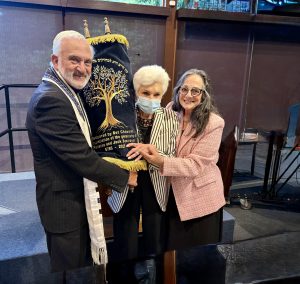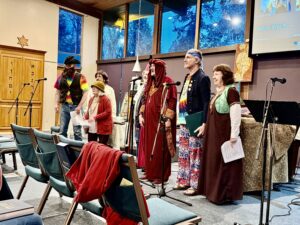Archie Levine delivered earlier this month at the Solidarity Day held at the ICE detention center.
Before launching into my little talk, I want to thank all of you for coming today. I also want to thank Rabbi James Mirel, who would have been here if he didn’t have prior, out-of-town commitments, for placing his trust & confidence in my ability to speak in his stead. And most importantly, I want to thank La Resistencia for the important work they’ve been doing & for hosting us.
“The alien residing among you must be treated as your native-born. Love them as yourself, for you were foreigners in Egypt. I am the LORD your God.” – Leviticus 19:34
This commandment is repeated multiple times in the Hebrew Bible:
“Do not mistreat or oppress a foreigner, for you were foreigners in Egypt.” – Exodus 22:21
“He defends the cause of the fatherless and the widow, and loves the foreigner residing among you, giving them food and clothing. And you are to love those who are foreigners, for you yourselves were foreigners in Egypt.” – Deuteronomy 10:18–19
The Bible and our long history are replete with episodes of us being driven to foreign lands, being conquered & oppressed in our own land, and persecuted in lands to which we’ve fled.
I have to admit that I haven’t always lived up to these standards. The Jewish people haven’t always lived up to these standards. Even the God of our Bible hasn’t lived up to the standards set forth in the Bible. And I doubt that anyone here has lived up to this standard. We all can and must do better.
History has also taught us that, even if the oppressors don’t come for us first, they will eventually come after us. I’m sure we are all familiar with the poem by Pastor Martin Niemoeller:
First they came for the Communists
And I did not speak out because I was not a Communist…
Last January, on Holocaust Remembrance Day, I sent a reminder to the Bet Chaverim Congregation about Pastor Niemoeller’s poem and stated that his list is incomplete. Before they came for the Communists, they came for the Trans people & other members of the queer community, AND they came for the immigrants.
I say these things as a reminder that, as in all major faith traditions, Empathy, Compassion, and Equality before the Law are our ideals and our guiding principles. I stand here as a human being, and as a Jew to state and affirm that what goes on in this building is not RIGHT! Is not JUST! The fact that these immigrants, PEOPLE like you and me, are held here and at more than 200 other detention centers across the US, AND the way they are treated in them is cruel & inhuman! And none of us, whether we adhere to a faith tradition or not, none of us can tolerate what goes on here. As human beings, we MUST NOT tolerate this…not because we might be next on the chopping block (which we may well be), but because we lose our humanity when we sit back and do nothing. We must raise our voices…we must call or write our congress people and our state representatives…write our newspapers & use our social media…get out on streets and protest…and be here to bear witness.
Thank you.
Thank you Reverend Ryan.
Now, in a moment I will ask all of you to close your eyes and focus inside. But first, if it feels right for you and it’s acceptable to a person next to you, take their hand. If not, just imagine and recognize the presence and support of everyone around you.
And now, close your eyes & focus inside. Focus your attention to all that loving-kindness that you just cultivated…the loving kindness that continues to radiate from your heart to all the people being held captive in the detention center here and in the centers across the country. And draw strength from the people standing next to you. Recognize that you are not alone… WE are here together, supporting each other… And in numbers there is strength. We have the power to make a difference! We, along with the thousands of others across the country… standing together are making a difference!
Take that knowledge…that certainty…that strength that is growing as we grow in number…add to it your measure of loving kindness, and make a commitment to do SOMETHING!
To call or write your congressperson or your state representative!
To write your local paper or post on your social media!
To join some group standing in protest!
Or just voice your opinion to neighbors, friends, and family!
Just one little thing more than you’ve done so far,
Know that we are making a difference!
Thank you!










